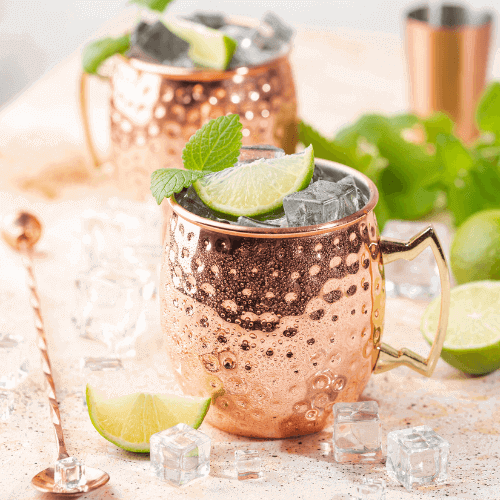Facebook Print Email WhatsApp Updated: 01/07/24 Table of Contents The Golden Dream cocktail is made with Cointreau, orange juice, heavy...
Updated 01/30/24

The Moscow Mule is a well-known cocktail, made with vodka, lime juice, and ginger beer. It is renowned for its refreshing taste and iconic copper mug presentation, has a fascinating origin story, and has a significant impact on cocktail culture.
Contrary to what its name might suggest, the Moscow Mule is an American invention with no direct ties to Moscow. Its creation is often traced back to 1941 in Manhattan, New York, within the walls of the Chatham Hotel. The narrative involves three individuals: Jack Morgan, John G. Martin, and Rudolph Kunett. Morgan was at the helm of Cock ‘n’ Bull Products and owned a restaurant in Hollywood that shared the brand’s name. Martin presided over G.F. Heublein Brothers Inc., and Kunett ran the vodka division under Heublein.
The trio, seeking innovation and perhaps a bit of serendipity, found themselves experimenting with a mix of vodka, ginger beer, and a dash of lime. This experiment resulted in a beverage that was not only refreshing but also a solution to a surplus problem. The initial tasting was promising, leading to further refinement and the eventual naming of the cocktail as the Moscow Mule.
Interestingly, another narrative surfaced in 2007, shedding light on Wes Price, the head bartender at Morgan’s Hollywood Cock ‘n’ Bull Restaurant, as the true inventor of the cocktail. According to this account, the Moscow Mule was conceived out of necessity to clear out excess stock, including vodka and ginger beer. This version of the story highlights the practical motivations behind the drink’s creation, contrasting with the more romanticized account of its invention.
The Moscow Mule quickly gained popularity. Its rise to fame can be attributed to several factors, including its unique serving vessel. The copper mug, now synonymous with the Moscow Mule, does more than just add visual appeal, it enhances the drinking experience by keeping the beverage chilled and accentuating its ginger and citrus flavors.
The drink’s association with Hollywood glamour and the clever marketing strategies employed by its creators helped cement its status as a fashionable choice. Celebrities and socialites were often seen enjoying Moscow Mules, further boosting its profile and desirability.
Several reasons contribute to the Moscow Mule’s sustained popularity. Firstly, its simplicity and the balance of flavors make it accessible and enjoyable for a wide audience. The spicy kick of ginger beer combined with the tartness of lime and the smoothness of vodka creates a refreshing beverage that is both invigorating and satisfying.
Moreover, the Moscow Mule is versatile, lending itself to numerous variations and adaptations. Bartenders across the globe have experimented with different ingredients, introducing new twists on the classic while maintaining its essence. This adaptability ensures the Moscow Mule remains relevant and appealing to contemporary tastes.
The insights into the origin of the Moscow Mule within this article draw information from a 1948 New York Herald Tribune article, shedding light on the cocktail’s intriguing history.
60 ml vodka
15 ml fresh lime juice
120 ml ginger beer, to top
Ice
Garnish: lime wedge

Fill a copper mug with ice, and add the vodka and fresh lime juice.
Top off with the ginger beer.
Garnish with a lime wedge.
Our Team
Hi, we’re mixdrinkipedia team. Welcome to our cocktail corner of the web, crafted by our dedicated team, passionate about everything that makes mixology magical. We’re a group of enthusiasts and professionals, blending our diverse skills and backgrounds to create a space where the art of cocktails is celebrated from intricate recipes and deep dives into the history of cocktails to reviews on the latest in bar tools. Join us as we explore the art and science of mixology, one sip at a time.
Newest Recipes
Facebook Print Email WhatsApp Updated: 01/07/24 Table of Contents The Golden Dream cocktail is made with Cointreau, orange juice, heavy...
Table of Contents Glassware storage solutions were created to store glassware and protect it from breakage and damage. Glassware storage...
Facebook Print Email WhatsApp Updated: 01/23/24 Table of Contents Malibu and Pineapple is a 2 ingredient cocktail made with Malibu...
Facebook Print Email WhatsApp Published: 02/04/24 Table of Contents The Gibson is a time-honored cocktail, made with gin and dry...
MixDrinkiPedia.com is a participant in the Amazon.com Services LLC Associates Program. As an Amazon Associate we earn from qualifying purchases. Amazon and the Amazon logo are trademarks of Amazon.com, Inc. or its affiliates.